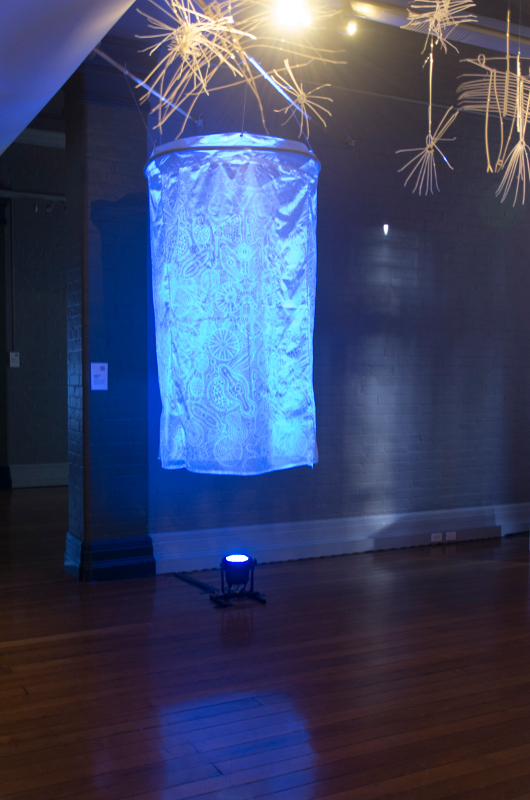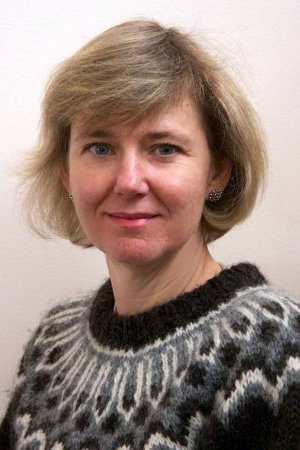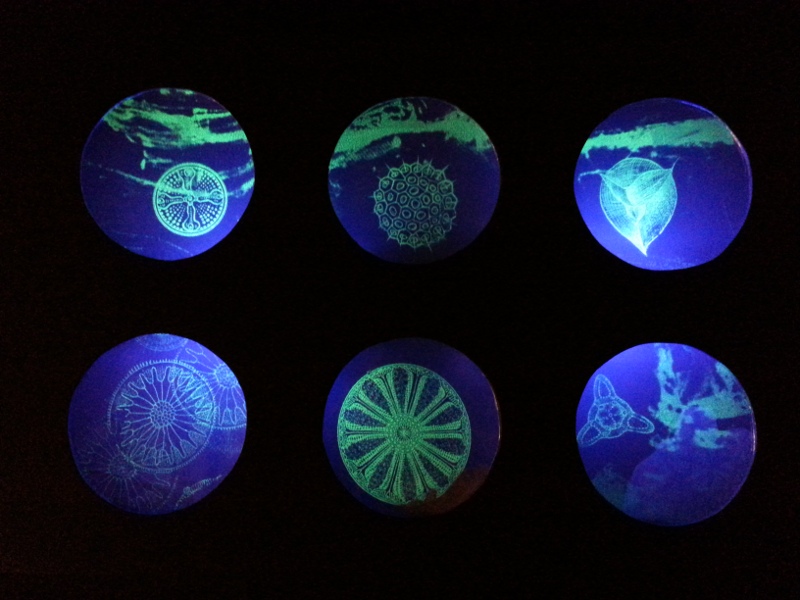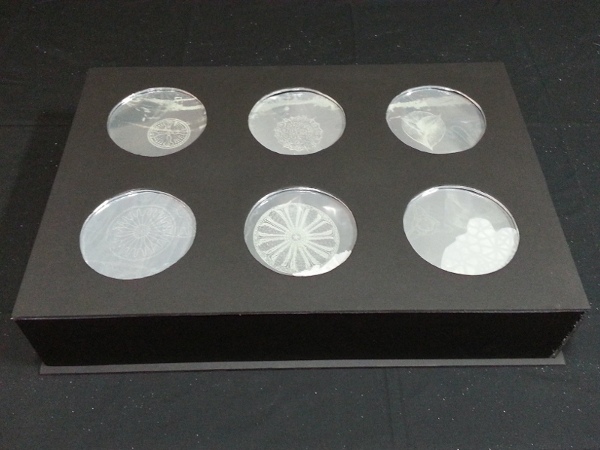Living Data
Science Art & Talks
The experiential process of observation and reflection is key to art and science
and is an essential component in understanding interdependence
of all species and ecosystems, terrestrial and aquatic.
Paul Fletcher Animator
Science Art & Talks
Living Data Program for the 2013 Ultimo Science Festival, Sydney, September 12-21.
Phytoplankton Courante [Fr. running] Objects and print media (installation) by Eveline Kolijn
Microscopic phytoplankton are the foundation of Life and are threatened by our massive consumption of fossil fuels.
Illuminated objects are made that suggest microscopic views and myriad phytoplankton running around the globe.

Eveline Kolijn
OceanVeil 2000mm (h) 3620 (circumference)
Hand-cut and block-printed tulle, 2013
Photo: Stephen Pierce
Living matter is inseparably connected within the geological envelope of the earth.
My childhood was spent beachcombing the seashore of Venezuela and browsing through illustrated books on evolution and natural history. In my teens, I learnt scuba diving in the Caribbean, and observed and recorded the natural habitats of the shells my father and I collected. These early experiences influenced my development as an artist, and fostered my interest in the connection between art and science. Involvement with taxonomy made me sensitive to form and pattern in nature.
My interest in science is expressed through printmaking and small, sculptural installations made from found synthetic materials. By constructing organisms from plastic and Styrofoam, which share the same source as petroleum, I connect consequences of the consumption of fossil fuels in our society with the beauty and fragility of the natural world.
Inspiration for my work flows from exploring the concepts of the Biosphere, of living matter being inseparably connected within the geological envelope of the earth. My work has attracted attention of marine biologists and microbiologists. These personal ties enhance my understanding of the biological sciences and led to invitations to visit laboratories and to present on the connection between art and science to an audience of scientists.

Eveline Kolijn
I am a Canadian printmedia and multidisciplinary artist. I experienced an international childhood and received a Master's degree in Cultural Anthropology from the Rijksuniversiteit Leiden, The Netherlands. I graduated from the Alberta College of Art + Design in Calgary with a Bachelor of Fine Arts in print media in 2008 and am the recipient of the Governor General's Academic medal. I have exhibited nationally and internationally, most recently in Ireland, China and the Netherlands. I have served on the boards of Alberta Printmakers Society and the THIS IS MY CITY art society, which creates art programming for citizens at risk of homelessness. I am currently an Extended Studies instructor at the Alberta College of Art + Design and a teacher for the Royal Music Conservatory's Learning Through The Arts program. This spring I was an invited speaker at an EMBO microbiology workshop at the University of Heidelberg, Germany. In the fall I will also visit the Norris Cancer Centre and University of Southern California to embark on an art-science project on genomic research into lung-cancer.
My most recent publication is Observation and visualisation: reflections on the relationship between science, visual arts, and the evolution of the scientific image,in a special issue of the Antonie van Leeuwenhoek Journal in the fall of 2013.
Notes for exhibition designers:

Luminous Specimens I, 2013 illuminated with UV blacklight. 575mm (w) 385mm (d) 120mm (h)

Luminous Specimens I, 2013 575mm (w) 385mm (d) 120mm (h)
To evaluate how reciprocity works in Living Data and how our program could be improved, I ask contributors,
What do you most value about our work?
What have you contributed?
How have you benefited?
How could our program be improved?
Eveline Kolijn, Artist, Canada
What do you most value about our work?
The core objective of the Living Data program, how to translate science into art, in which dry scientific data and arcane subject matter gets translated into a visual, audio, tactile and/or motile experience and from which the public can take away this mixture of understanding and emotions on the topic, is very valuable to me. I prefer to create art with content, which means it is primarily created for themed exhibitions and not for commercial purposes. I have a tremendous interest in biological and climate change science, and respect for those who do research in the field.
What have you contributed?
In participating, I have contributed time (hours: to pin it down, with all included at least 100 hours), all materials (including those used for experimenting, but not used for the end product) and postage for sending the pieces to Australia. So participating has cost me quite a lot of money. This is why I have a varied art-practise, in which I also make more commercial work, teach, create for commisions, etc, which funds part of my non-commercial work, which is what I enjoy most to create.
How have you benefited?
Participating in this project as an artist provided me with a focus to research and create at the same time, for a specific goal (the exhibition). Contributing to this exhibition has been very meaningful for me, because environmental and climate change issues regarding the oceans and ocean science are one of the core subjects on which I base my art. The kinds of exhibitions like Living Data, usually do not result in commercial gain for an artist. What the artist gains, however, is public exposure of their work (which may result in new opportunities) and experience. It is possible, that a museum or other institution decides to buy an exhibited piece, which will recoup or even pay for the actual costs mentioned above, but that is not a given.
How could the Living Data program be improved?
I think it would be very useful for the organizer of the exhibition, to try and team up interested artists and scientists as early as possible, so the scientists can share some of their research topics with an artist, who can give thought on creating a piece based on that specific information. I don't think this has to take a lot of the scientist's time, but providing info, and then being willing to give feedback on questions the artists may have, and to verify whether the science gets translated properly. I think an artistic piece can have a lot of license and freedom, but for Living Data it can not be ignorant of the proper science. So trying to team up artists and scientists well in advance would be a major suggestion from my part for future exhibitions. Another benefit of this is that it will give an artist more content and authority to define their project when applying for grants.
There is the option for an artist (depending on country of residence) to apply to several granting organizations to fund a piece made for the exhibition. Depending on the funds, these could range from covering material costs, installation and shipping and even paying for the artist to come attend the opening or arrive early for creating work on site. The organizers of the exhibition can also look into funding options for the exhibition and apply for money, so they are able to cover installation costs, production of a catalogue with essays, and even pay out artist-fees to participating artists.
So in order to be able to apply for funding, a more structured theme and approach would have to be in place early in the process, to allow for grants to be submitted and awarded. Connected to this are suggestions on how to make the art even more closely connected to the science. Now that Living data is in its second year of exhibiting for the Ultimo Science festival, and has even grown exponentially, some more advance planning becomes more feasible. Hopefully, there is an increased roster of artists and scientist who would like to participate again, or other artists and scientists who are starting to hear about this event and want to come on board. Curatorial decisions must still apply. In my case, I made art based on things I have been reading on ocean science in general, but not fitted to specific research of a scientist. I can imagine, that the scientists would like to see more pieces like Lisa's Krill animation, which was created for a very specific body of research.











